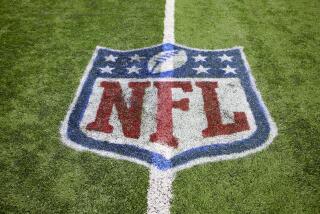Court orders a currency redesign to aid the blind
WASHINGTON — The Treasury Department on Wednesday began considering its response to a federal court ruling that ordered changes to paper currency so each denomination could be easily identified by blind and visually impaired people.
The ruling by U.S. District Judge James Robertson came in a lawsuit filed against the department by the American Council of the Blind, a Washington-based advocacy group. The group argued that the government’s failure to differentiate among denominations amounted to illegal discrimination, and Robertson agreed.
“We are still reviewing the court order, and the government has made no determination as to what its next step will be in this matter,” said Charles Miller, a spokesman for the Justice Department’s civil division.
The Treasury Department has 10 days from Tuesday’s ruling to decide whether to appeal.
In his opinion, Robertson ordered the Treasury Department to consider such options as changing the size and color of banknotes for each denomination and adding tactile differences, such as foil, raised numbers or perforations, to the bills.
Other currencies, such as those of the European Union, Japan, Switzerland and Saudi Arabia, include such differences, he said, adding that the United States could have incorporated similar changes during recent redesigns that added anti-counterfeiting features.
The government has argued that doing so would prove a financial burden. But Robertson said that making one change -- adding a raised numeral -- would have increased the government’s $4.2-billion cost of manufacturing currency over the last decade by only 5%.
“Of the more than 180 countries that issue paper currency, only the United States prints bills that are identical in size and color in all their denominations,” the judge wrote.
That puts blind and low-vision individuals at the risk of being cheated if they are unable to identify the value of paper money without help from others, he said.
The issue has divided the visually impaired community, with some believing that the ruling reinforces negative stereotypes.
“We believe in solving real problems of discrimination -- not in doing gimmicks that look like they solve a problem and could make things actually worse,” James Gashel, executive director for strategic initiatives at the National Federation of the Blind, said Wednesday. “For a federal court to say that we are being discriminated against is simply wrong.”
But the American Council of the Blind, which filed the lawsuit four years ago, was “very happy” with the ruling, said Executive Director Melanie Brunson.
“We don’t see it as a negative, and we believe that it could improve opportunities for blind people,” she said, enabling them to work at cash registers or as vendors.
According to the National Institutes of Health, about 3 million Americans have a visual impairment that cannot be corrected with glasses or contact lenses.
*
More to Read
Sign up for Essential California
The most important California stories and recommendations in your inbox every morning.
You may occasionally receive promotional content from the Los Angeles Times.








